Occupational environment monitoring at a foam manufacturing factory
99,000 ₫
Note: The above price is calculated for one sample. Prices may vary depending on the area of the environment to be monitored and market fluctuations. For more accurate pricing, please refer to the price list or contact our consulting staff directly.
Monitoring the environment of foam production factories involves collecting, analyzing, and evaluating workplace factors that may be harmful to workers health.
Table of Contents
Toggle1. Overview of the Foam Manufacturing Factory
a. What is a foam manufacturing factory?
Factory producing foam, also known as a Styrofoam factory, is a production facility specializing in manufacturing and processing products made from foam materials, where Styrofoam is a trademark of the polystyrene system widely used.
Foam, including Styrofoam, is a lightweight, heat-insulating, and soundproof material made from polystyrene.

b. Production stages in a foam manufacturing factory
The foam production process in the factory may include the following stages:
- Material preparation: Polystyrene and other additives are prepared and measured according to the appropriate ratio.
- Melting process: The polystyrene material is placed into a melting machine where high temperatures are applied to turn the material into a liquid form.
- Chemical reaction: During melting, additives and catalysts are added to the polystyrene mixture to create a chemical reaction. This process may involve natural decomposition, gas generation, or chemical reactions to produce gas.
- Foaming process: The molten liquid is poured into molds or foaming systems where it expands and forms foam. This occurs due to the reaction between the blowing agent and polystyrene in the liquid.
- Cooling and quality inspection: After foaming, the foam product is cooled to solidify and checked for quality, including elasticity, weight, size, and thermal insulation properties.
- Cutting and processing: Foam can be cut into sheets or specific shapes using cutting machines or other equipment. Additional processing stages such as surface finishing, insulation treatment, or shaping may be performed to create the final foam product.
- Packing and transportation: The foam products are packed and prepared for shipment to customers or final product manufacturers.

c. Types of machinery used in a foam manufacturing factory
A foam manufacturing factory uses various machines to carry out production processes. Some commonly used machines include:
- Melting machine: Used to melt polystyrene and other additives to create molten liquid.
- Air compressor: Provides compressed air to create pressure and push the molten liquid through the system.
- Foaming machine: Used to combine the molten liquid with additives and chemical reactions, producing gas and foaming effects during expansion.
- Cutting machine: Used to cut expanded foam into desired sizes and shapes, which can be automatic or manual.
- Cooling machine: Used to cool the expanded foam, solidifying it and maintaining its shape.
- Quality inspection machine: Used to check the properties of foam after production, including elasticity, weight, size, and thermal insulation.
- Packing machine: Used to pack foam products into smaller units or according to customer requirements.

d. Occupational diseases that may occur for workers in a foam manufacturing factory
Workers in a foam manufacturing factory may be exposed to harmful environmental factors and potential hazards, causing some occupational diseases including:
- Respiratory diseases: Workers may inhale toxic chemicals or dust from foam production, causing respiratory issues such as rhinitis, sinusitis, pneumonia, or other respiratory illnesses.
- Allergies: Some individuals may have allergic reactions to additives or chemicals used in foam production, causing symptoms like eye irritation, itching, swelling, or skin allergies.
- Skin diseases: Prolonged exposure to chemicals during foam production can cause irritation and dermatitis, including contact dermatitis, eczema, or other skin problems.
- Chemical poisoning: Certain additives and compounds may be toxic and can cause chemical poisoning if workers are exposed beyond safe limits or improperly.
- Accidents: During work, there is also a risk of occupational accidents, especially when handling machinery and equipment that may cause injury.
To ensure safety and protect worker health, safety measures should be implemented, such as maintaining effective ventilation, using personal protective equipment, providing occupational safety training, and complying with regulations and procedures related to foam production.

e. Popular types of foam on the market
There are many types of foam widely used across various industries. Some common types include:
- Polystyrene Foam (EPS): The most common type, used in packaging, insulation, construction, and art.
- Polyurethane Foam (PU): Offers good thermal insulation and durability, widely used in construction, furniture, automotive, and industrial applications.
- Polyethylene Foam (PE): Commonly used in packaging, product protection, insulation, and medical applications.
- Polypropylene Foam (PP): Has good mechanical properties, fire resistance, and chemical resistance, used in automotive, toys, household items, and various industries.
- EVA Foam (Ethylene Vinyl Acetate): Flexible and elastic, commonly used in sports equipment, toys, footwear, and daily products.
- PVC Foam (Polyvinyl Chloride): Fire-resistant and chemically resistant, used in construction, toys, medical, and electronic products.
- Neoprene Foam: Water-resistant and heat-resistant, used in protective equipment, sports products, and industrial applications.
2. Overview of Occupational Environment Monitoring Services
a. What is occupational environment monitoring in a foam manufacturing factory?
Occupational environment monitoring (or workplace environmental measurement) in a foam manufacturing factory involves collecting, evaluating, and analyzing measurement indicators of workplace environmental factors to implement timely interventions, minimize environmental harm to worker health, and prevent occupational diseases. Occupational environment monitoring is a mandatory requirement for foam manufacturing factories.
Monitoring plays a crucial role in caring for, protecting, and enhancing worker health because the workforce is the main resource of the enterprise and directly generates profit. Workers exposed to risk factors or occupational hazards exceeding permissible limits may suffer health impacts and occupational diseases.
REGISTER FOR OCCUPATIONAL ENVIRONMENT MONITORING SERVICE
b. Nam Viet occupational environment monitoring program
Nam Viet’s occupational environment monitoring program is developed by monitoring engineers in occupational safety and environmental protection. Aimed at ensuring health and safety for workers, this program uses modern measurement methods to monitor air, water, microclimate, physical factors, dust, and other workplace elements. This program is crucial for maintaining a safe working environment and protecting worker health.
Additionally, Nam Viet’s program plays an important role in researching and developing new solutions to improve workplace environment quality. With the dedication and professionalism of its monitoring experts, Nam Viet’s exclusive monitoring program has become a breakthrough in occupational safety management and environmental protection in Vietnam.

c. Standardization in workplace environmental measurement procedures
Standardization in Nam Viet’s workplace environmental measurement procedures is crucial for ensuring accurate and reliable results. To guarantee precision and reliability, the program uses standards and standardized procedures recognized by the Ho Chi Minh City Department of Health. This ensures that collected data is highly reliable for workplace environment assessment and for making decisions to improve workplace conditions and protect worker health.
These standardized procedures also ensure that measurements are conducted by highly qualified monitoring experts with extensive experience, allowing managers and specialists to trust Nam Viet’s results and make accurate, valuable decisions in safeguarding worker health and the environment.
By applying standardization in environmental measurement procedures, Nam Viet demonstrates its commitment to providing a safe working environment and protecting workers’ health, while actively contributing to the development and improvement of occupational safety and environmental management in Vietnam.
d. Reporting results of occupational environment monitoring in foam factories
Occupational environment monitoring results are compiled according to Form No. 04, Appendix III issued with Decree 44/2016/ND-CP and prepared in two copies: one sent to the workplace that contracted the monitoring service and one kept by the monitoring organization.
The retention period for occupational environment monitoring results follows legal regulations, requiring indefinite record storage.

e. Frequency of occupational environment monitoring according to legal regulations
According to Clause 2 of Article 18 of the Occupational Safety and Hygiene Law 84/2015/QH13, employers must organize occupational environment monitoring to assess harmful factors at least once a year.
f. Deadline for submitting occupational environment monitoring reports according to the law
The deadline for submitting the report is before December 31 each year. Enterprises in production facilities must submit monitoring results to the Department of Health at the locality where the production facility or business headquarters is located and where employees work.
When there are changes in technology, production processes, or during renovations or upgrades that may introduce new hazardous factors to worker health, enterprises must update occupational hygiene records regarding harmful factors requiring environmental monitoring.
g. Penalties for violations of occupational environment monitoring for employers
According to Article 27 of Decree No. 12/2022/ND-CP dated January 17, 2022, regulating administrative penalties in labor, social insurance, and Vietnamese workers working abroad under contracts:
- Clause 2: Fines from 2,000,000 – 5,000,000 VND for employers who do not publicly disclose monitoring results and hazard management evaluations to employees immediately after obtaining the results at the monitored site.
- Clause 3: Fines from 20,000,000 – 40,000,000 VND for employers who fail to conduct occupational environment monitoring to control health hazards as required by law.
- Clause 4: Fines from 40,000,000 – 60,000,000 VND for employers who collude with monitoring organizations to commit fraud in occupational environment monitoring activities but have not yet reached criminal liability.
3. Harmful Environmental Factors for Workers in Foam Manufacturing Factories
Workers in foam manufacturing factories may be exposed to harmful environmental factors. Below are some potential environmental hazards that can affect workers’ health:
- Dust: The foam production process may generate dust from cutting, processing, and handling foam. Exposure to foam dust can cause irritation to the eyes, nose, throat, and lungs. Long-term inhalation may lead to respiratory problems and lung diseases.
- Chemicals: Foam production may use additives, chemical compounds, and solvents. Exposure to these chemicals can cause skin irritation, allergies, or harm the nervous system, respiratory system, and other organs.
- Fumes and toxic vapors: Foam manufacturing can release fumes and toxic vapors such as formaldehyde, volatile organic compounds, and other chemicals. Exposure to these vapors can cause respiratory, eye, skin, and nervous system problems.
- Noise: Machinery and equipment in foam manufacturing factories can generate high noise levels. Prolonged exposure to noise may cause hearing issues and stress the nervous system.
- Temperature and humidity: Foam production may create work environments with high or fluctuating temperature and humidity. Unfavorable conditions can cause fatigue, dehydration, heat stress, or other health issues.
REGISTER FOR OCCUPATIONAL ENVIRONMENT MONITORING SERVICE
4. Measures to Improve the Working Environment in Foam Manufacturing Factories
To improve the working environment in foam manufacturing factories and protect workers’ health, the following measures can be applied:
- Dust management: Use dust extraction systems and ventilation fans to remove dust during production. Ensure proper hygiene and cleanliness in the work area.
- Chemical management system: Implement safety measures for handling, storing, and using chemicals. Provide instructions on chemical usage and ensure workers are trained on workplace safety.
- Ensure proper ventilation: Maintain effective ventilation systems to remove fumes and toxic vapors from the workspace. Adjust equipment to control the concentration of emissions during production.
- Noise assessment and control: Evaluate noise levels in the factory and implement measures to reduce noise to safe levels. Provide ear protection for workers and comply with noise regulations.
- Temperature and humidity adjustment: Ensure effective climate control systems to create comfortable working conditions for workers.
- Training and education: Provide training on occupational safety and health. Educate workers about environmental hazards and how to prevent occupational diseases.
- Compliance with safety regulations and standards: Follow regulations and safety standards related to foam production. Ensure proper use of personal protective equipment, safe work procedures, and waste management regulations.
- Regularly conduct occupational environment monitoring in factories, collect and analyze harmful factors affecting workers, and adjust operations to reduce hazards to prevent occupational diseases.
5. Benefits of Regular Monitoring in Foam Manufacturing Factories
An Toan Nam Viet provides businesses with excellent benefits when using occupational environment monitoring services in accordance with Decree 44/2016/ND-CP on managing and controlling harmful factors in the working environment affecting employees.
- Businesses can proactively control harmful factors in workshops or factories.
- Receive recommendations on measures to minimize harmful factors and improve the quality of the working environment.
- Indirectly protect human resources, a key factor in business development.
- Reduce the impact of occupational diseases on employees’ health, thereby minimizing future treatment costs.
- Improved employee health ensures consistent product quality and maintained production output.
- Comply with labor safety laws, avoiding legal risks.
- Enhance credibility and professionalism in all aspects, elevating the company’s brand.
An Toan Nam Viet’s environmental monitoring service is a solution to minimize the impact of occupational diseases, contributing to a clean and high-quality working environment.

6. Nationwide Occupational Environment Monitoring Center
Occupational Environment Monitoring Center of An Toan Nam Viet is a professional unit for supervising and measuring workplace environmental quality across all provinces in Vietnam. With an experienced team of monitoring specialists, the center uses modern measurement equipment, ensuring accuracy and reliability.
In addition to monitoring services, the center supports clients in planning, handling, and tracking workplace environmental issues. Following the motto “customer-centered,” the center prioritizes client satisfaction, meets all client needs, and commits to delivering the best solutions for businesses.
REGISTER FOR OCCUPATIONAL ENVIRONMENT MONITORING SERVICE
With investments in technology, equipment, and human resources, An Toan Nam Viet’s monitoring center has become a reputable unit in occupational environment monitoring in Ho Chi Minh City, with the following goals:
- We always value our brand reputation and service quality.
- We provide clients with the best and most suitable solutions possible.
- With a team of experienced Masters and Engineers aiming to protect the environment and benefit businesses.
- Choosing An Toan Nam Viet Environmental Monitoring ensures professional service from experts and the best cost advantages.
The occupational environment monitoring process at An Toan Nam Viet includes the following steps:
- Before conducting monitoring, ensure all machines and equipment are calibrated and verified according to legal regulations.
- Strictly follow monitoring procedures committed to the Department of Health.
- Report monitoring results honestly to employers.
- If results indicate unsafe conditions for workers, An Toan Nam Viet will provide solutions, and the workplace will implement as follows:
- Implement measures to improve working conditions, minimizing exposure to harmful factors and preventing occupational diseases.
- Organize medical check-ups to detect occupational diseases and related conditions early for employees in unsafe environments.
- Provide in-kind compensation to employees according to labor law.

7. Occupational Environment Monitoring Price List
To help businesses conduct occupational environment monitoring professionally and effectively, An Toan Nam Viet provides clients with a high-quality and reasonably priced monitoring service price list.
- Our price list provides detailed information about the costs of our monitoring services, including fees related to transportation, measurement, analysis, and reporting. Clients can be assured of the accuracy and reliability of our monitoring reports.
- We are committed to offering the most competitive and reasonable prices on the market and are always ready to answer any questions about monitoring services quickly and professionally.
- With An Toan Nam Viet’s monitoring price list, clients can easily select service packages that suit their needs. We guarantee the highest satisfaction with professional service quality.
No comments yet

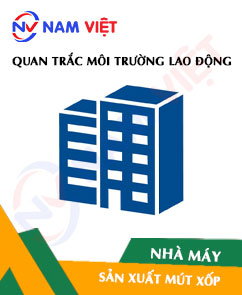
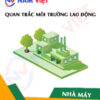
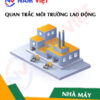

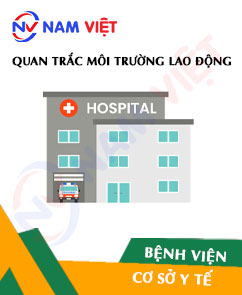
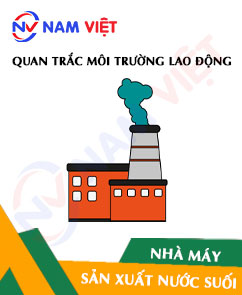
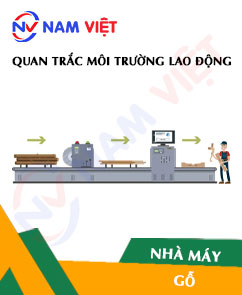
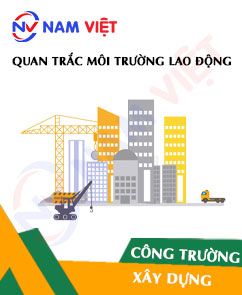

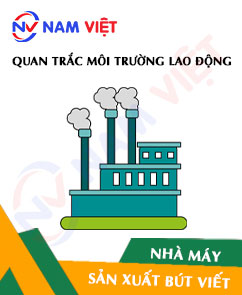
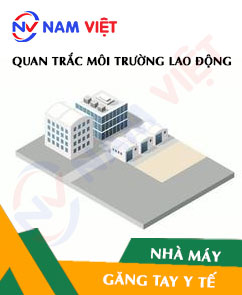
Review Occupational environment monitoring at a foam manufacturing factory
There are no reviews yet.